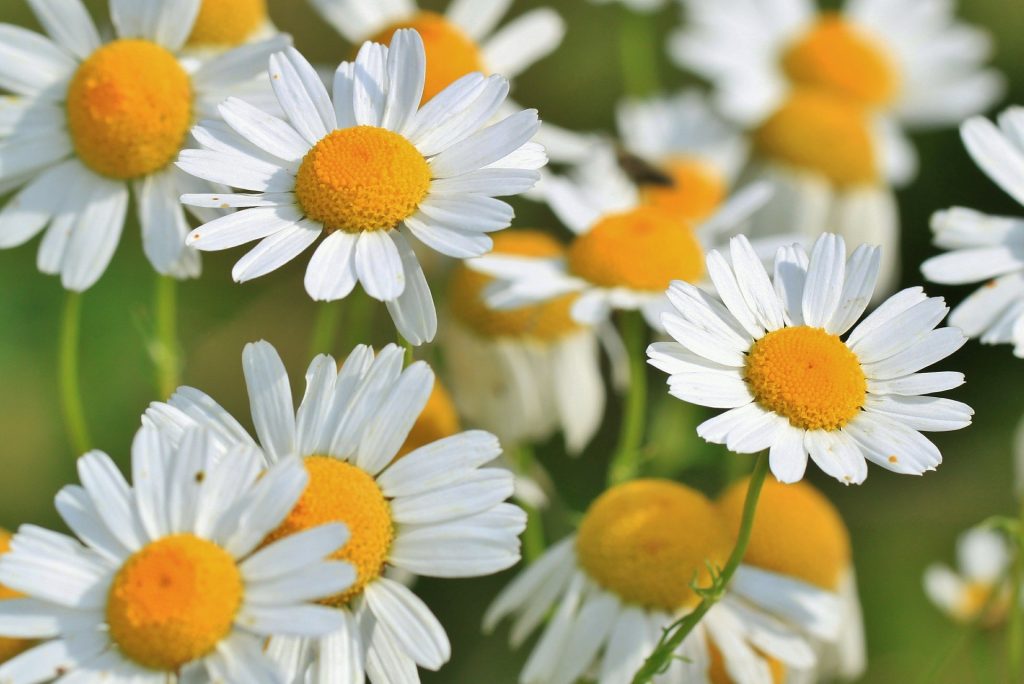 Chamomile (Matricaria chamomilla) has a long traditional use as a herbal medicine. Chamomile (English spelling, camomile) is one of the most well known herbal medicines and is instantly recognisable for its ‘daisy-like’ appearance. Chamomile contains a number of active ingredients including terpenoids, flavonoids, coumarins and phenolic acids. A volatile oil can be extracted from the plant and this oil is composed of a variety of separate oils. The flavonoid apigenin is perhaps the most researched of the components in chamomile, due to its anxiolytic effects in human and animals. The apigenin content of the plant may be where chamomile obtains its calmative and sedative properties from. Chamomile is available commercially in a number of forms and the extracts are often made from the dried flowers. Ethanol and methanol extracts can produce a dry powder that contains up to 1.2 % apigenin in its free form. Water extracts such as chamomile tea do not contain much free apigenin, but instead provide apigenin-7-O-glucoside.
Chamomile (Matricaria chamomilla) has a long traditional use as a herbal medicine. Chamomile (English spelling, camomile) is one of the most well known herbal medicines and is instantly recognisable for its ‘daisy-like’ appearance. Chamomile contains a number of active ingredients including terpenoids, flavonoids, coumarins and phenolic acids. A volatile oil can be extracted from the plant and this oil is composed of a variety of separate oils. The flavonoid apigenin is perhaps the most researched of the components in chamomile, due to its anxiolytic effects in human and animals. The apigenin content of the plant may be where chamomile obtains its calmative and sedative properties from. Chamomile is available commercially in a number of forms and the extracts are often made from the dried flowers. Ethanol and methanol extracts can produce a dry powder that contains up to 1.2 % apigenin in its free form. Water extracts such as chamomile tea do not contain much free apigenin, but instead provide apigenin-7-O-glucoside.

Chamomile refers to a number of species of flowering plant belonging to the Asteraceae (daisy) family. The most commonly used chamomile in herbal medicine in German chamomile (Matricaria chamomilla). However, garden or English chamomile (Chamaemelum nobile) may also be used. Many species fall under the umbrella term chamomile, and these plants may possess broadly similar phytochemical profiles and medicinal properties.
However, as well as its sedative properties, chamomile also displays a number of other health effects that make it a useful herbal remedy. The high content of antioxidants in chamomile extracts would suggest that it may have particular anti-inflammatory effects. Research has shown that the volatile oil possesses anti-inflammatory effects which may be due to the α-bisabolol, matricin and flavonoids it contains. When applied topically, the flavonoids and essential oils of chamomile penetrate the surface of the skin providing an anti-inflammatory effect to lower layers. This anti-inflammatory effect may stem from inhibition of the cyclooxygenase enzyme system, a common target of anti-inflammatory compounds. The anti-inflammatory effects of chamomile may also explain its cardioprotective and antidiabetic effects, as these diseases are increasingly being seen as having an inflammatory component. Topical application of chamomile has also been shown to be as or more effective than hydrocortisone cream at treating eczema.

The beneficial effects of chamomile as a medicinal preparation derive from the phytochemicals it contains. These phytochemicals include a number of terpenoids and flavonoids. The sedative effects of apigenin are thought to be due to the presence of the flavonoid apigenin.
A possible anti-cancer effects for chamomile has been investigated in cell culture models. For example, experiments show that extracts of chamomile can kill cancer cells, however, at the same time, the same extracts show minimal adverse effects for normal, non-cancer cells. Chamomile may also possess anti-viral effects. Subjects that inhaled steam with chamomile extracts had significant reductions in the severity of the symptoms of a common cold. Chamomile extracts have also been shown to inhibit the development of sore throats. Further, studies have shown that chamomile containing herbal preparations, and chamomile and fibre preparations are beneficial against cases of colic in children. The anti–inflammatory effects of chamomile may also make it effective at treating gastrointestinal disorders and may accelerate wound healing. Therefore chamomile appears to possess a number of effects that demonstrating its efficacy as a herbal medicine, while demonstrating a very high level of safety.
Eat Well, Stay Healthy, Protect Yourself
RdB
